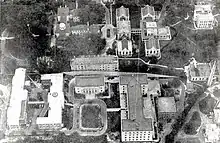Old Naval Observatory
The Old Naval Observatory is a historic site at 23rd and E Street in Northwest, Washington, D.C.. It is where the United States Naval Observatory was located from 1844 to 1893, when it moved to its present grounds. The original observatory building, built 1839-40, still stands, and is a designated National Historic Landmark.[2] The Washington meridian of 1850 passes through the Observatory. The property for many years housed the Navy's Bureau of Medicine and Surgery, which moved out in 2012. The property has been taken over by the State Department.
Old Naval Observatory | |
.jpg.webp) | |
   | |
| Location | 23rd Street and E Street, N.W., Washington, D.C. |
|---|---|
| Coordinates | 38°53′42″N 77°03′05″W |
| Built | 1844 |
| Architect | James Gilliss |
| NRHP reference No. | 66000864 |
| Significant dates | |
| Added to NRHP | October 15, 1966[1] |
| Designated NHL | January 12, 1965[2] |
It was declared a National Historic Landmark in 1965.[2][3]
History
Observatory
The observatory operated from 1844 to 1893 when it was closed in favor of a new U.S. Naval Observatory facility on Massachusetts Avenue.[4] The Moons of Mars were discovered from this site in 1877.
The building and grounds were retained by the U.S. Navy, which first used it to house the Naval Museum of Hygiene from 1894 to 1902.
Naval Medical Hospital and National Institute of Health

Beginning in 1903, the Naval Medical Hospital was constructed on the grounds, and it remained in use until 1942, when hospital operations were transferred to the National Naval Medical Center in Bethesda, Maryland.[4]
The U.S. Public Health Service Hygienic Laboratory, later the National Institutes of Health, moved to the campus in 1904 from the Marine Hospital in Stapleton, Staten Island. Five buildings would be built in 1904, 1915, 1919, 1934, and another one in the early 1930s. In 1938, NIH moved to a new campus in Bethesda, Maryland.[5]
Navy Bureau of Medicine and Surgery and CIA
The facility housed the Navy's Bureau of Medicine and Surgery from 1942 until 2012.[5][6] The Office of Strategic Services and its successor the Central Intelligence Agency were located on the campus from WWII until 1961.[5]
In 1963, multiple buildings were demolished to construct the E Street Expressway.[5]
Department of State
The grounds and observatory are closed to the public. The entire Navy Hill is being transferred to the United States Department of State due to Base Realignment and Closure, and the Navy will be moving out. The Central Intelligence Agency's forerunner, the Office of Strategic Services was a tenant on the Hill during World War II, and the United States Public Health Service had a hospital there.
In 2014, the Department of State began expanding into the Navy Hill. A joint venture consisting of the architectural firms of Goody, Clancy and the Louis Berger Group won a $2.5 million contract in January 2014 to begin planning the renovation of the buildings on the 11.8-acre (4.8 ha) Navy Hill campus.[7]
References
- "National Register Information System". National Register of Historic Places. National Park Service. January 23, 2007.
- "Old Naval Observatory". National Historic Landmark summary listing. National Park Service. Archived from the original on 2011-06-06. Retrieved 2008-05-12.
- Blanche H. Schroer and Steven H. Lewis (March 3, 1977). "National Register of Historic Places Inventory-Nomination: Old Naval Observatory". National Park Service. Cite journal requires
|journal=(help) and Accompanying nine photos, exterior and interior, from 1873, 1975, and undated - Inci A. Bowman (September 13, 2006). "Historic Medical Sites in the Washington, DC Area". National Library of Medicine. Cite journal requires
|journal=(help) - Harden, Victoria A.; Lyons, Michele (2018-02-27). "NIH's Early Homes". The NIH Catalyst. Retrieved 2020-09-28.
- Pilip-Florea, Shonona. "Navy Medicine Headquarters Moves to Falls Church, Va." America's Navy May 30, 2012 Accessed 2014-05-16.
- Sernovitz, Daniel J. "Boston Firm Picked for State Department Consolidation." Washington Business Journal. January 14, 2014. Accessed 2014-01-14.
External links
| Wikimedia Commons has media related to Old United States Naval Observatory. |
- Historic American Buildings Survey (HABS) No. DC-341, "Old Naval Observatory, Twenty-Third & E Streets Northwest, Washington, District of Columbia, DC", 2 photos, 2 data pages, 1 photo caption page